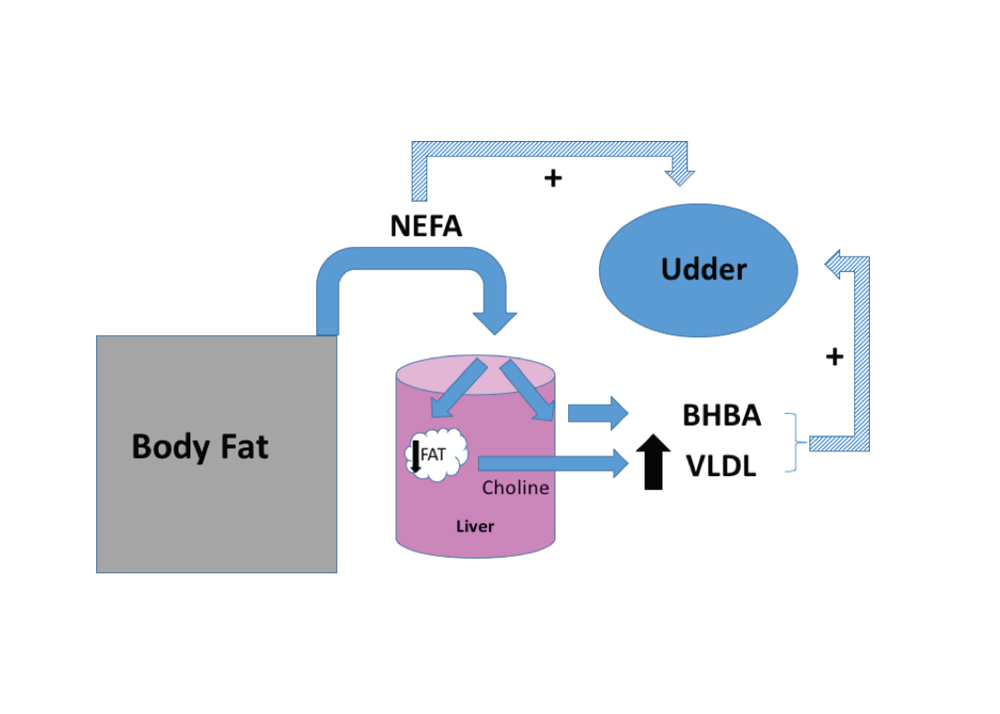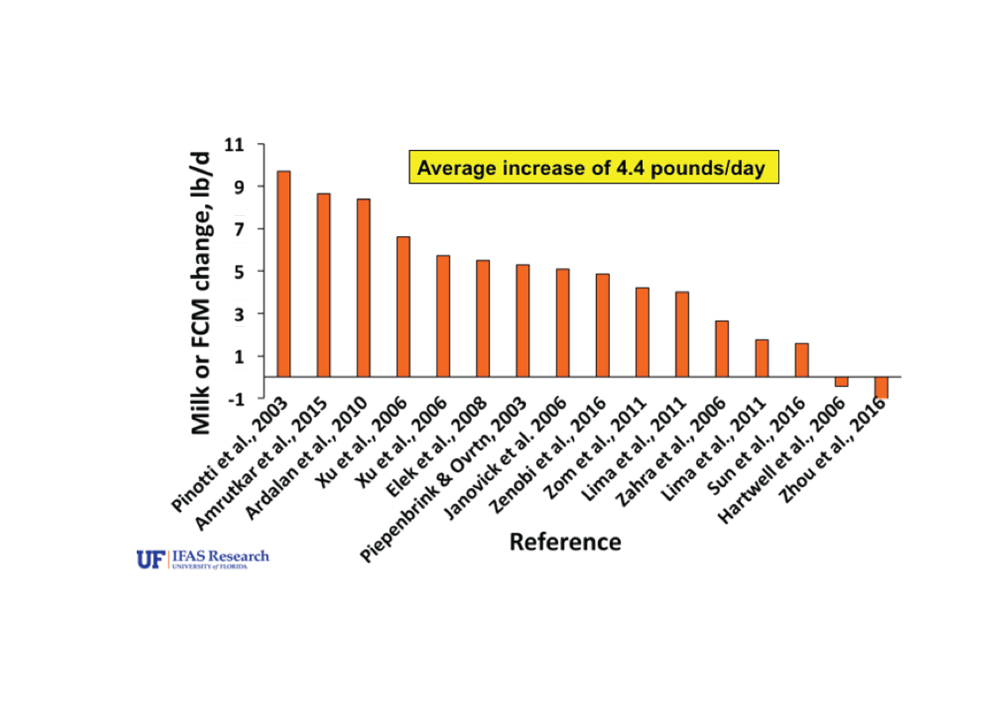Myth #2: The Best Way to Combat High Blood NEFA is to Inhibit Fat Mobilization
Because of the extensive evidence for potential negative outcomes associated with elevated NEFA and BHBA, several large epidemiological studies have been conducted to identify a critical blood concentration in which negative effects may be expressed in transition cows. Since BHBA are far more commonly measured than NEFA, it has been the focus of many of these studies. The studies are fairly consistent in suggesting that 1.2-1.4 mmol BHBA/L is the point in which milk production is likely to be reduced. Consequently, it is commonly recommended that if 10-15% or greater of the cows tested are at 1.2 (or 1.4) mmol BHBA/L or above, an alarm level has been reached and causes should be identified.
BACKGROUND
In the last mythbuster article, we discussed body fat mobilization in transition cows and the wide perception by our industry that the elevation in blood nonesterified fatty acids (NEFA) and beta-hydoxybutyrate (BHBA) that results is bad for the cow. We busted that myth by explaining that NEFA and BHBA are not necessarily bad and can support lactation by serving as precursors for milk fat synthesis and as energy sources for milk synthesis. Clearly, there are occasions when the elevation in blood NEFA (and BHBA which may result from partial oxidation of NEFA in the liver) can be exaggerated to the point in which negative effects occur in the cow. Historically, the approach to resolve this situation has been to provide feed additives or treatments that act on fat tissue to inhibit fat mobilization and reduce NEFA entry into blood and subsequent uptake by the liver (Figure 1).
*FIGURE 1
The traditional approach to managing fat mobilization which results in fewer nutrients being available to the udder for milk production.

BUSTING THE MYTH: THE FIRST APPROACH TO MANAGING FAT MOBILIZATION SHOULD BE TO HELP THE LIVER DEAL WITH ELEVATED UPTAKE OF NEFA RATHER THAN TO PREVENT MOBILIZATION OF FAT
There are situations in which suppression of fat mobilization has had a negative impact on lactation performance by restricting nutrients to the udder (Janovick et al., 2010; Yuan et al., 2012); this will be a topic of a future mythbusting article. Dr. John Newbold summarized quite nicely the potential negative aspect of the traditional approach (Newbold, 2005):
“Nutritional restriction to adipose tissue mobilisation might be necessary, but there is a philosophical problem. We have selected cows that have increased reliance on mobilised body reserves as a source of nutrients for milk production. The farmer has paid the geneticist for this- are we now going to ask him to pay the nutritionist to work in the opposite direction? We have our priorities wrong. We should explore what can be done to help the liver deal with mobilised fatty acids before considering whether we need to try to reduce the amount of fatty acid supplied to the liver.”
Dr. Newbold’s brilliant concept for preferred management of fat mobilization is shown in Figure 2 and contrasts the historical approach shown in Figure 1. His idea is to use the liver to help export the NEFA to the mammary gland as a very low-density lipoprotein (VLDL) rather than to have the fat be stored in the liver or be converted to BHBA. In other words, help the cow to avoid fatty liver, ketosis, and all the related complications that come with it.
*FIGURE 2
An improved approach to manage fat mobilization. By supplementing rumen-protected choline you support lactation by not restricting fat mobilization and by facilitating fat export from the liver to the udder.

TAKE HOME MESSAGE
The first approach to managing fat mobilization should be to help the liver! The only known compound to facilitate that is choline. Dietary choline is an essential nutrient, but unfortunately it is extensively degraded in the rumen. Therefore, it must be supplemented in a form that protects it from ruminal degradation. The mechanism of action for choline is to enhance phosphatidylcholine synthesis which is required for VLDL assembly and fat export by the liver (Chandler et al., 2017). Numerous studies have shown that supplementation of rumen-protected choline reduces fat accumulation when dry or transition cows experience intense periods of NEFA mobilization (Cooke et al., 2007; Zom et al., 2011; Elek et al., 2013). As suggested by Dr. Newbold, choline supports lactation rather than reduces the availability of nutrients (NEFA and BHBA) to the mammary gland. Two summaries of transition cow trials have shown that supplementation of rumen-protected choline increases milk production 4.9 (13 studies, Grummer, 2012) or 4.4 pounds of milk per day (Staples, unpublished, Figure 3).
*FIGURE 3
A summary of milk yield responses when feeding rumen-protected choline to transition dairy cows.

Sources
CHANDLER, T. L. AND H. M. WHITE. 2017.
Choline and methionine differentially alter methyl carbon metabolism in bovine neonatal hepatocytes. Plos One doi.org./10.1371/journal pone.0171080.
COOKE, R. F., N. SILVA DEL RIO, D. Z. CARAVIELLO,
S. J. Bertics, M. H. Ramos, and R. R. Grummer. 2007. Supplemental choline for prevention and alleviation of fatty liver in dairy cattle. J. Dairy Sci. 90: 2413-2418.
ELEK, P., T. GAAL, AND F HUSVETH. 2013.
Influence of rumen-protected choline on liver composition and blood variables indicating energy balance in periparturient dairy cows. Acta Vet. Hung. 61:59-70.
GRUMMER, R. R. 2012.
Choline: A limiting nutrient for transition dairy cows. Proc. Cornell Nutr. Conf.
JANOVICK, N. A., AND J. K. DRACKLEY. 2010.
Prepartum dietary management of energy intake affects postpartum intake and lactation performance by primiparous and multiparous Holstein cows. J. Dairy Sci. 93:3086-3102.
JANOVICK, N. A., Y. R. BOLSCLAIR, AND J. K. DRACKLEY. 2011
Prepartum dietary energy intake affects metabolism and health during the periparturient period in primiparous and multiparous Holstein cows. J. Dairy Sci. 94:1385-1400.
MCNAMARA, J. P., AND F. VALDEZ. 2005.
Adipose tissue metabolism and production responses to calcium propionate and chromium propionate. J. Dairy Sci. 88:2498-2507.
NEWBOLD, J. 2005.
Liver Function in dairy cows. Page 257 in Recent Advances in Animal Nutrition. P.C. Garnsworthy and J. Wiseman, eds. Nottingham University Press.
YUAN, K., R. D. SHAVER, S. J. BERTICS, M. ESPINEIRA, AND R. R. GRUMMER. 2012.
Effect of rumen-protected niacin on lipid metabolism, oxidative stress, and performance of transition dairy cows. J. Dairy Sci. 95:2673-2679.
ZOM, R. L. G, J. VAN BAAL, R. M. A. GOSELINK, J. A. BAKKER, M. J. DE VETH, AND A. M. VAN VUUREN. 2011.
Effect of rumen-protected choline on performance, blood metabolites, and hepatic triacylglycerols of periparturient dairy cattle. J. Dairy Sci. 94:4016-4027.
